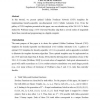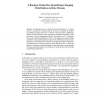1414 search results - page 49 / 283 » Randomness and Universal Machines |
APAL
2006
13 years 8 months ago
2006
We investigate the question of whether one can characterize complexity classes (such as PSPACE or NEXP) in terms of efficient reducibility to the set of Kolmogorovrandom strings R...
IJBC
2007
13 years 8 months ago
2007
In this tutorial, we present optimal Cellular Nonlinear Network (CNN) templates for implementing linearly-separable one-dimensional (1-D) Cellular Automata (CA). From the gallery ...
PKDD
2005
Springer
14 years 2 months ago
2005
Springer
In applications such as fraud and intrusion detection, it is of great interest to measure the evolving trends in the data. We consider the problem of quantifying changes between tw...
DSD
2005
IEEE
13 years 10 months ago
2005
IEEE
Several methods improving the fault coverage in mixed-mode BIST are presented in this paper. The test is divided into two phases: the pseudo-random and deterministic. Maximum of f...
CORR
2010
Springer
13 years 6 months ago
2010
Springer
Abstract. We propose a method to exponentially speed up computation of various fingerprints, such as the ones used to compute similarity and rarity in massive data sets. Rather the...


